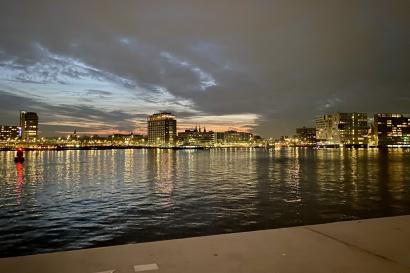While most of my classes are geared towards my psychology major back at home, I knew I wanted one of those courses to help me orient to Dutch culture/way of life. This came in the form of my IES Abroad Highlights of Dutch Art class. Every Tuesday afternoon, my class of ~10 people gathers at the IES Abroad Amsterdam Center to hear small presentations from each other, dissections of Dutch artists and their pieces by our professor, and for our ventures to museums around the city and beyond. IES Abroad provides us with the Museumkaart, which allows free entry into most museums in the Netherlands—a card that I am happy to say gets plenty of usage! Our excursions to museums has propelled me to seek out other museums, highlighted in this post. Here are some favorites I have visited.
Rijksmuseum
The largest + most frequented museum I have visited is the Rijksmuseum, which sits atop Museumplein (a large, beautiful courtyard, surrounded by various museums and ConcertGebouw). I remember biking past this museum to get to school at the beginning of my semester, and having no idea what it was! It is such an eye-catching building—I really enjoy how you can bike + walk through its open center. Rembrandt’s The Night Watch is located here, along with other Dutch artists we have studied in our course: Jan Steen, Johannes Vermeer, Jan van Scorel, the list goes on. Despite visiting three times, I have only explored ¼ of the museum—I hope this speaks to the size!


Koninklijk Paleis Amsterdam
The Royal Palace on Dam Square caught my eye the first day I arrived in Amsterdam—so, I wanted to present it as part of our Dutch Art class. Constructed in the 17th century as a city hall, it was the most grand secular building at the time. It now receives the Dutch royal family when they are visiting Amsterdam, and serves as a museum/event venue otherwise. There is currently restoration to the palace’s sandstone facade, but the inside was nothing short of enchanting.



Our Lord in the Attic
Did you know that some of Amsterdam’s characteristic canal houses were converted into hidden churches in the 17th century? This particular one, tucked away in the attic, has been restored to resemble what the church would’ve looked like when it was used in the late 1600’s. These were Catholic churches—at the time, a Protestant city council mandated that Catholicism could not be practiced in public. Our Dutch Art professor regaled us with facts about the church and its owner as we explored the corridors and rooms.
Van Gogh Museum
I get to visit this museum with my art class later in the semester, but decided to go recently with a couple of friends. This museum was truly beautiful, holding the largest collection of Van Gogh's paintings, drawings, and letters to friends and colleagues. I feel this museum does a fantastic job of acquainting us with Van Gogh’s life and journey as an artist—I found myself fascinated by the ways his work changed as he ventured from the Netherlands to France, learning impressionist techniques and harnessing color theory to create contrast in his paintings.



Kröller-Müller Museum
On the note of Van Gogh, The Kröller-Müller Museum (situated in a national park in the NL—awesome!) has the second largest Van Gogh collection in the world. I visited this museum prior to the Van Gogh Museum, and it sparked my interest in Van Gogh’s work before he moved to Paris in 1886. They consisted of dark colors, and often depicted peasant life. The Potato Eaters, pictured above, is one of his most notable works that depicts this.



Our class recently ventured to Haarlem, a 15 minute train ride from Amsterdam, to visit two museums:
Teylers Museum
The oldest museum in the Netherlands, the Teylers Museum feels like an artifact in itself: cataloging fossils, gemstones, old coins, and a beautiful collection of paintings. The owner of the museum wanted to dedicate it to science—an element that reminded me of science museums I adored as a kid.



Frans Hals Museum
After exploring the Teylers Museum, our class enjoyed some tea and walked to the Frans Hals Museum. This art museum is home to a large Frans Hals collection, who specialized in painting group portraits. One particular room was filled with such portraits—our class paused to adorn ourselves with 17th century attire provided by the museum, while a classmate presented about Hals. The museum also had some modern pieces of art that I particularly loved.

I appreciate how integral museums have been to my life in Amsterdam. They are a favorite way to immerse myself in Dutch culture, and I am inspired to visit more museums while I am here and back at home in the United States. Our class has a particular trip planned to Den Haag later in the semester for museum visits—I can’t wait!

Brooke Lackey
Brooke is from Winston Salem, NC, United States, and is a student at the University of Amsterdam this fall. She enjoys being outside, thrifting, and reading good books in good coffee shops. She is also a CODA, fluent in American Sign Language.






